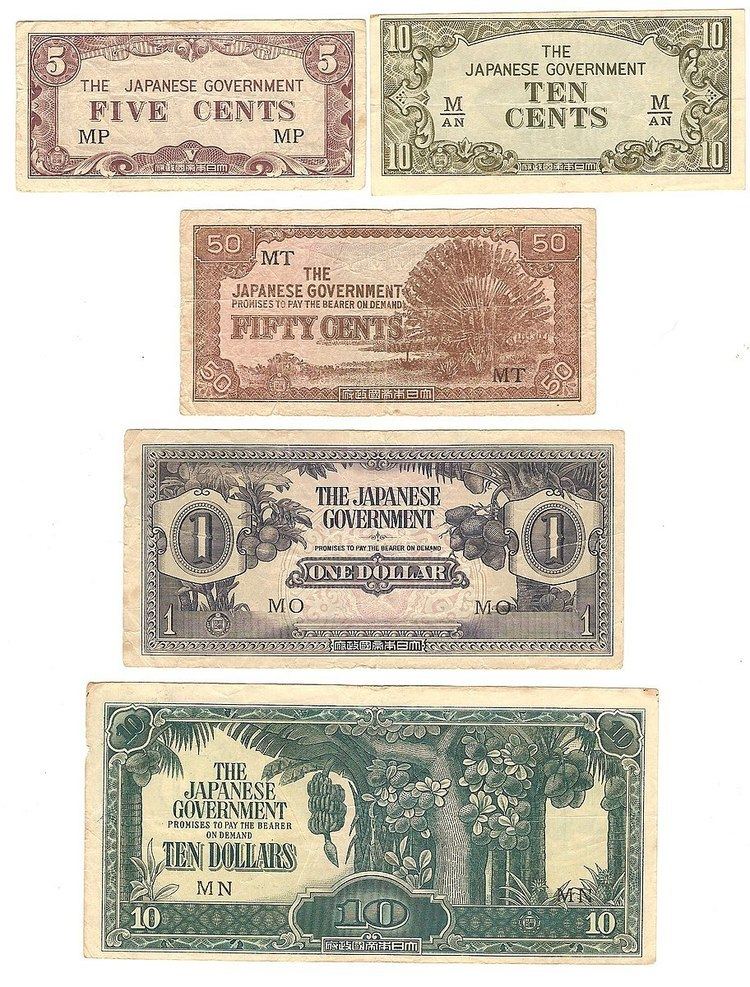1/100 cent cent cents Coins none | Plural dollars Symbol $ | |
 | ||
Banknotes 1, 5, 10, 50 cents. 1, 5, 10, 100, 1000 dollars. | ||
The Japanese government-issued dollar was a form of currency issued for use within the Imperial Japan-occupied territories of Singapore, Malaya, North Borneo, Sarawak and Brunei between 1942 and 1945. The currency was also referred informally (and with more than a trace of contempt) as banana money (Malay: duit pisang), named as such because of the motifs of banana trees on 10 dollar banknotes. The Japanese dollar was in widespread use within the occupied territories where the previous currency became a scarcity. The currency were referred to as "dollars" and "cents" like its predecessors, the Straits dollar, Malayan dollar, Sarawak dollar and British North Borneo dollar.
Contents
The Japanese dollar was one of several forms of Japanese invasion money issued throughout the then newly expanded Empire of Japan. Similar currencies were issued in Burma (as the Japanese rupee), the Dutch East Indies (as the Japanese gulden/roepiah), the Philippines (as the Japanese peso) and various Melanesian and Polynesian territories (as the Japanese pound).
History
Following the fall of Singapore into the hands of Imperial Japan on 15 February 1942, the Japanese introduced new currencies as a replacement of those previously in use in the occupied territories of Malaya, North Borneo, Sarawak and Brunei. The new currency in Malaya and Singapore were issued with the same value as the Malayan dollar, and first entered circulation in 1942. As with other currencies issued by Japan in occupied territories, local residents were forced to adopt this type of currency, while existing coins were allowed until a shortage of coins required the Japanese administration release issued notes for cents. Although new coins bearing the name "Malaysia" and dated under the Japanese calendar were planned by the Osaka Mint for the region, these never made it passed the concept stage and only a few rare patterns exist.
To supply the authorities with money whenever they required it, they simply printed more notes. This resulted in hyperinflation and a severe depreciation in value of the banana note. Moreover, counterfeiting was rampant due to its lack of a serial number on many notes. Increasing inflation coupled with Allied disruption of Japan's economy forced the Japanese administration to issue banknotes of larger denominations and increase the amount of money in circulation. Sharp drops in the currency's value and increased price of goods frequently occurred following a Japanese defeat in battle abroad.
After the surrender of Japan, the currency became entirely worthless, and to this day the Japanese government has refused to exchange these currencies. Some locals managed to escape poverty because they had hidden Straits dollars and Malayan dollars, the previous currencies before the Japanese invaded. Those with hidden stashes of the old dollars were thus able to use them the moment the British resumed control of Singapore and surrounding colonies, when they became valid again. A number of surviving banknotes were stamped as war souvenirs, while its use as printing paper for rudimentary calendars for 1946 was also recorded. When these notes became obsolete, punch holes were made in the notes to indicate they had been "cancelled" and stripped of redeemable value.
The present value of the currency as a collector's item remains mixed depending on their condition, the presence of serial numbers, the use of woven paper, and their use as specimens. Common notes lacking serial numbers are still worth below their printed value, while rarer versions are worth slightly over or several times their printed value. Notes stamped as war souvenirs are currently rare, while notes with 1946 calendar overprints fetch about RM3,000 (as of September 2006).
Ten dollar-sized leaflets reprinting the ten dollar note's obverse were also airdropped by British air forces during the Japanese occupation as a warning to the population on the potential worthlessness of the currency in the event of Japanese defeat. Fear among the population of possessing the leaflet lead to their rarity and present high value (at an estimated RM3,000 as of September 2006).
